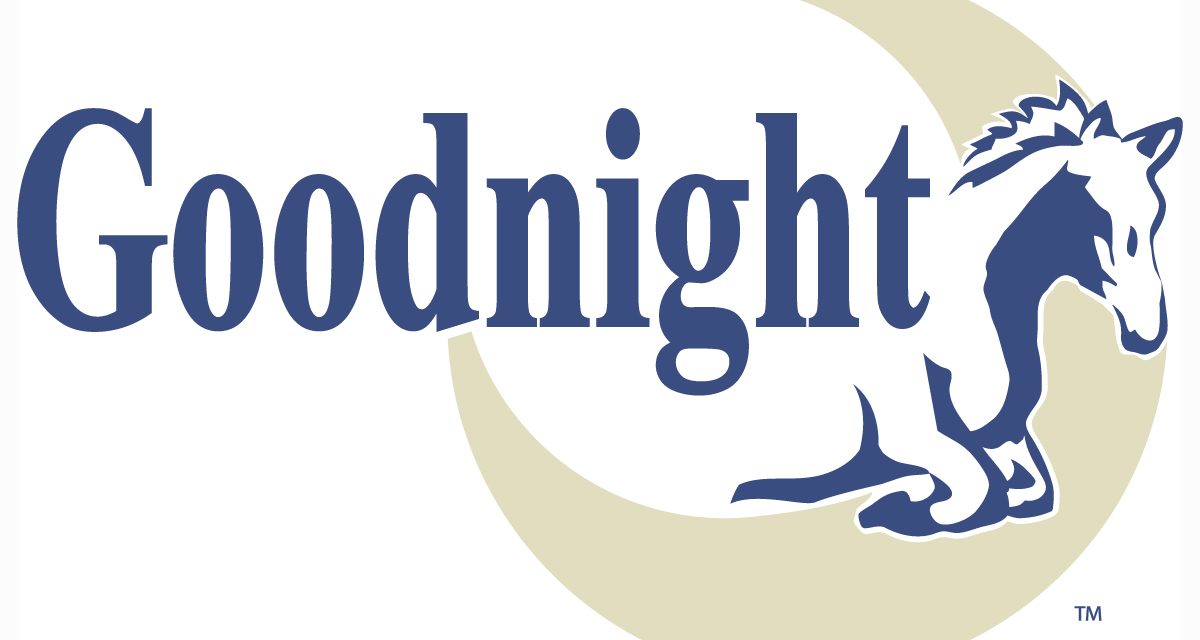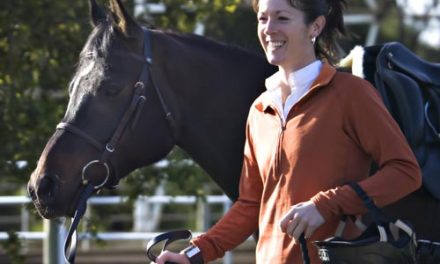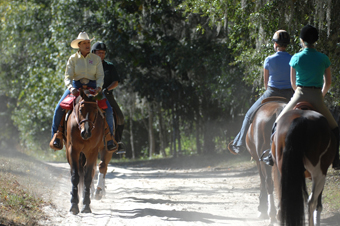Ask Julie Goodnight
 What’s the difference in Western and English riding? Especially when it comes to “contact?”…
What’s the difference in Western and English riding? Especially when it comes to “contact?”…
Question: Dear Julie,
I have ridden Western for the last 20 years, and have trained my horses based on the resistance free method or natural horsemanship as it is most commonly known today. I ride my current horse in a Myler bit with a short shank that has the independent side motion as I tend to go back and forth between two hands or one.
I recently started taking Classical Dressage lessons and I am struggling most with the reins. I’m so used to releasing a rein when the horse does what I ask, or using a rein to ask the horse to drop it’s head and relax, and yet the dressage horse I ride seems to look for or even need that contact. My instructor describes contact as holding my child’s hand – not too tight, but don’t let go either. This is so counter intuitive for me since I don’t understand how to reward the horse I’m riding without releasing the rein. Can you help me understand the necessity of contact? How do you calm down a chargey horse that needs to be on contact? Can you ride on contact constantly, or should it just be for certain maneuvers? Can a horse go back and forth? Is contact better? I’m really struggling to understand the why and how.
Thank you so much,
Sharon
Answer: Sharon,
Thank you for some very thought provoking questions—questions that I have pondered a lot myself over the years. To me, the most challenging difference between English and Western riding is the difference in contact. I switched from English to Western an had to learn to give up the direct contact on the mouth—it took me almost two years to break the habit and learn to let go of my horse. You are switching from Western to English and need to learn to ride with contact so that your horse can rely on it and balance on steady pressure.
Contact is contact, whether it is an ounce of contact in each hand, a pound of contact or five pounds (and BTW—riding on a loose rein is not riding “off contact” because the horse can still feel your hands and any movement you make, even with slack in the reins). A horse that is ridden on direct contact learns to rely on the contact in part for his balance, just like when you hold a horse’s foot up to work on it—he should not be leaning on you but he can rely on your contact to help him balance on three feet. So a horse that becomes accustomed to riding on direct contact will often search for the contact and throwing the reins away can be a lot like suddenly dropping out from under a horse’s leg without warning and letting his foot slam to the ground. He can regain his balance, but it would be nice if you gave him some warning before you dropped his foot.
To simplify, English horses balance on the contact and are reliant on the rider to hold the desired frame, while Western horses are required to hold themselves in the frame on a loose rein (self-carriage). English horses go “on the bit” (searching out contact and stretching into the bridle) while Western horses come off of the pressure from the bit. Western horses learn that if they hold themselves in the desired frame or give to bit pressure, they will find a release and that is known as coming off the bit or seeking out slack. English horses come to rely on the contact for balance. It is really just a matter of what the horse is used to.
However, for either English or Western horses, the release of pressure is always the reward, but that release can be relative. You can still give a release of pressure when riding on contact without throwing the reins away. For example, as you ask for more collection, you will increase the contact with rhythmic alternating rein pressure; when the horse comes into the frame you want, you can soften your hands, softening the contact, without going to a loose rein. It is still a release and still a reward. For more information on using the reins in advanced maneuvers like collection and lateral movements, see volume 5 in my riding DVD series, Refinement and Collection.
A “chargey” horse is indicative of a training problem and riding with or without contact is probably not the solution. I’d first rule out a physical problem for his anxiety, then I’d look to the bit to see if something could be done to make the horse more comfortable in his mouth (one of the biggest sources of anxiety in hot horses) then I would look to better training to deal with disobedience. A horse that is properly trained and obedient should not change speed unless signaled to do so by his rider. It is quite likely that with a chargey horse I might spend more time riding on a loose rein.
I like for all the horses I ride and train, whether English or Western, to be ridden both on contact and on a loose rein in every training session. I also like to ride them both in a natural, long and low frame and at various degrees of collection in each session. There’s no reason why a horse can’t do it all, if the rider can adjust.
If you are going to be riding on direct contact a lot, you might want to switch to a snaffle side piece instead of the short shank. Although the Myler short shank (HBT shank) is not much stronger than a snaffle, it does give a little more leverage (one pound of contact might mean 1 ½ or 2 pounds of pull). The great thing about the Myler bits is that you can get eh same mouthpiece on a shanked (curb) bit or a snaffle (direct pressure). I’ve written a lot about this, so check out some related articles in my training library.
I don’t think riding on-contact or on a loose rein is better or right or wrong, it just depends on what you are doing and the style of training. A well trained horse and a rider with soft and educated hands should be able to do it all.
Good luck!
–Julie Goodnight Trainer and Clinician
_________________________________
If you liked this article, Julie suggests watching the Myler’s free online videos at http://juliegoodnight.com/mylervideos.html and the following products to help you continue the work with your horse (http://shop.juliegoodnight.com or call 800-225-8827 for ordering help): The Goodnight Bitting System
The Goodnight’s Principles of Riding, 5-Part DVD Series
SIDEBAR
Horse Master Air Schedule
SPECIAL NEWS! Watch Horse Master with Julie Goodnight at its new time on RFD-TV starting in January! Mondays at 12:30 and 10:30 pm EST and Saturdays at 10:30 PST!
Week of January 2: HM401 Julie Goodnight: “R-E-S-P-E-C-T.” The Horse Master teaches a pushy, dangerous horse to lead respectfully. (2011)
Week of January 9: HM402 Julie Goodnight: “Losing Weight.” The Horse Master & Dale Myler find a bit for a jumping horse. (2011)
Week of January 16: HM403 Julie Goodnight: “Change of Reign.” The Horse Master empowers a reining rider to take charge, slow the canter. (2011)
Week of January 23: HM404 Julie Goodnight: “Once Bitten.” The Horse Master & Dale Myler find a bit for a gorgeous dressage prospect. (2011)
Week of January 30-February 1: HM405 Julie Goodnight: “Down Shift.” The Horse Master helps a rider slow down and choose his pace. (2011)
Find more free articles to read and refer to in Julie’s Training Library: http://juliegoodnight.com/q&a.php and watch Horse Master on RFD-TV every Monday at 12:30 and 10:30p EST —Direct TV channel 345, Dish Network channel 231 and on many cable outlets. Then visit http://www.horsemaster.tv and http://www.juliegoodnight.com/clinics for the clinic schedule, articles related to each episode, the gear used in each show, and for training DVDs and publications. Plus, see clips from each show at: http://www.horsemaster.juliegoodnight.com and check out specials and even more clips on Goodnight’s Facebook Fan Page: http://www.facebook.com/horsemaster.tv. Sign up for his free monthly newsletter at: http://juliegoodnight.com/emailsignup.php





